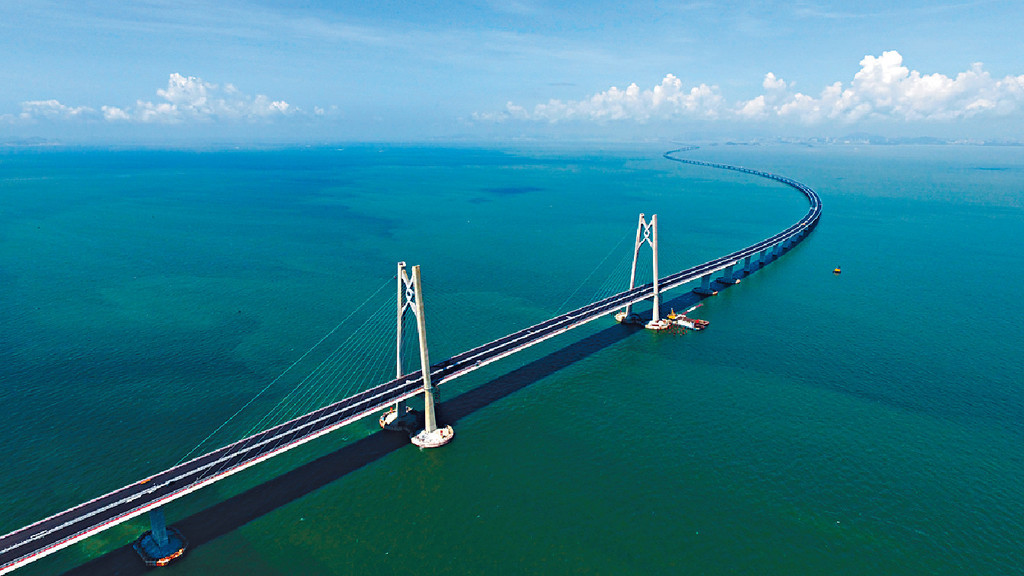2018/08/07

January, 2018
Robin Lee
Recently the ill-fated Hong Kong-Zhuhai-Macau Bridge (the HZMB) has been back in the news again. This time the reason was due to yet another budget overrun of HK$11.7 billion for which Hong Kong will need to pay a share of HK$2.36 billion. Hong Kong’s Legislative Council has previously allocated HK$110 billion to the bridge. In fact, since the bridge was first proposed, its financing and budget have been revised and obscured so many times that exact total costs remain unclear, suffice to say that it is significantly more than was originally outlined. Nevertheless, as part of a grand plan by China, the bridge, which at a length of 49.97km will be the world’s longest sea bridge upon its completion, can also in some ways be seen as symbolic of the position that Hong Kong has been placed in concerning China’s development, and not least its strategies to ‘go global’ and expand overseas as well as the failures and limits to this more generally.
Although construction of the HZMB first began in 2009, the project has been integrated into some of China’s wider plans both for regional and international integration. Through its later incorporation into the Bay Area, (a 2011 development plan by the Chinese government involving Hong Kong, Macau and nine cities in Guangdong province aimed at promoting and coordinating the economic and infrastructure development of the region and developing its function as a logistics hub), it has become considered important to China’s flagship Belt and Road Initiative (BRI) for overseas investment. The Hong Kong Trade Development Council has described the bridge as, “of special strategic value in anchoring the Bay Area as the investment services platform for the Belt and Road Initiative by accelerating economic integration and increasing regional competitiveness”.[1] Such scaling up in the significance of the bridge project has similarities to the way that as China has been expanding its outbound investment it has accorded much higher status to this through the launch of its BRI in 2015, and subsequently brought many of these existing projects under this umbrella giving them heightened political significance and impetus for officials to promote them regardless of costs. This might especially be considered so in the case of the HZMB since it has become criticized as constituting a white elephant project bearing significant cost to Hong Kong, but without realistic prospects of it paying for itself or of bringing meaningful benefits to people in Hong Kong.
Nevertheless, the repeated difficulties or failures in the construction of the bridge so far also have a lot in common with trends in China’s investment projects elsewhere, where overly ambitious plans have commonly come up against obstacles to their feasibility, due to a variety of reasons, including political, economic and practical restraints, contributing to the high overseas failure rates of Chinese projects overseas. Where projects are successful, however, as in the case of the HZMB they often not only come up against problems but have also contributed to difficulties or hardship for people in the locations where they are implemented.
Indeed, the bridge also mirrors how many of China’s cross-border infrastructure investment initiatives have had harmful effects on the environment[2] and/or for workers involved in their construction. The construction of the bridge has been criticized for its destruction of marine habitats, and in particular for putting Hong Kong’s already endangered pink dolphins even further at risk. The bridge has also come at a high human cost. Accidents at bridge construction sites have resulted in the deaths of ten workers and more than 600 workers being injured since work on the Hong Kong section of the bridge first commenced in 2011.
Furthermore, while corruption has been an issue reported relating to some of China’s overseas investments, the HZMB has also been marred by corruption and safety scandals, which the government has been slow, or has failed, to disclose. In mid-2017, for instance, 21 employees from a government contractor were arrested for allegedly faking concrete test reports, potentially jeopardizing the safety of the bridge[3]. In another incident, shortly before this discovery, it was revealed that the Highways Department had failed to disclose over two years earlier the collapse of two seawalls on reclaimed land, leading questions to be raised about potential cover-ups or illegal land reclamation[4]
That the Chinese and Hong Kong governments have so shamelessly pushed ahead and promoted this project should hardly be surprising. As a connecting point between mainland China and countries overseas, Hong Kong has long been crucial to China’s overall development enabling it to take such a prominent role on the world stage. Use of the Hong Kong stock market to raise capital continues to be an important example in this respect. Since the 1990s, for instance, state owned red chip companies have been an important form of investment in Hong Kong, in order to raise capital to help develop China’s economy and to raise funds for overseas investments. Hong Kong has also long been a destination for China’s outbound FDI –in 2015 it received more than 60% of China’s total outbound FDI– a large percentage of which is then believed to be channelled overseas or re-invested in China. Hong Kong also serves as an important financial and services hub, acting as a base for offices of many multinational corporations. While this has facilitated foreign multinationals doing business in China, it has also helped mainland multinationals in their expansion of investments overseas. Several of China’s strategic Belt and Road projects involve subsidiaries of Chinese multinationals that have been setup in Hong Kong. COSCO Shipping Ports Ltd., for instance, which is headquartered in Hong Kong and has investment in the Greek Port of Piraeus as well as the Khalifa Port in Abu Dhabi (both strategic along the BRI) amongst other international projects, is a subsidiary of Chinese state-owned China COSCO Holdings Company Limited which in turn belongs to China’s largest shipping company the COSCO group. Similarly, as an additional tool for China’s latest major outbound development initiative, the Bay Area, of which the HZMB is a part, is also intended to act as a bridge out and enhance China’s position globally. It will rival all other world bay areas, provide opportunities for international investors, facilitate regional connectivity and act as a logistical hub thereby helping to contribute to China’s growing status, or so their story goes[5].
The Hong Kong government has, of course, never keen to offend its mainland bosses or perhaps as a means for individuals to enhance their own political careers and/or business opportunities, actively promoted these initiatives. While lawmakers have been critical of the lack of consultation over plans for the Bay Area, the BRI has also seemingly been pushed at every occasion possible. This has not just been through the organisation of countless seminars and other events in the name of the BRI, amongst the most prominent being the two Belt and Road summits organised jointly with the Hong Kong Trade Development Council (the most recent was held in September 2017), but also through cultural activities such as art exhibitions, choir festivals and so on. Meanwhile Hong Kong’s public education system has also been put to use with, for instance through the establishment of a Research Centre on One-Belt-One Road (OBOR)[6] by City University of Hong Kong’s College of Business which aims to “create applicable business knowledge to support the national policy of OBOR”.[7] The research centre also runs a ten day training program on Public Private Partnerships and OBOR for government officials and business executives from the Greater China region, with the price for each participant listed as 60,000 RMB (the local currency in Hong Kong is the Hong Kong dollar). Indeed the eagerness of Hong Kong’s political elites to promote China’s plans for Hong Kong and its integration is also highlighted through the way that the former Hong Kong Chief Executive, Leung Chun-ying, who as Chief Executive had begun to heavily promote BRI, is a director of two companies, the Belt and Road Hong Kong Centre Company Limited and the Bay Area Hong Kong Centre Company Limited, that are related to these development plans. Although Leung became director of these companies on the same day that he stepped down as Chief Executive[8], he has denied any conflict of interest, stating that the companies are non-profit and that his role is unpaid.
Regardless, it is clear that those in power are determined to play along with Beijing’s script. With China’s National Development and Reform Commission (NDRC) having already earlier outlined a role for Hong Kong in its Vision and Action plan for the BRI, in mid-December 2017 this became yet further formalised when Chief Executive Carrie Lam signed an arrangement with the NDRC on ‘Advancing Hong Kong’s Full Participation in and Contribution to the Belt and Road Initiative’, which is intended to serve as a blueprint for Hong Kong’s involvement in the BRI and includes pushing forward the plan for the Bay Area.
Nevertheless, while the elites push this forward, furthering China’s cause of the greater economic and political integration of Hong Kong and simultaneously acting as part of the expansion of Chinese capital and political influence internationally, the plans and procedures for both the HZMB and the Bay Area have shown a disregard for people in Hong Kong and their autonomy. Although perhaps not directly to the same degree as the high-speed railway, another cross-border infrastructure project that under the proposed plans will allow for mainland law to be enforced on Hong Kong soil at the West Kowloon terminus checkpoint, these projects are nonetheless a part of the same picture. This is a picture which, in addition to the lack of transparency over financing for the bridge, has resulted in a lack of consultation more generally over plans for development as well as human and environmental costs. Moreover, even though it is important to recognise that Hong Kong has its own unique set of political circumstances governing its relationship with the Chinese mainland, similar factors have also been very prevalent as China spends on huge development projects overseas; a very notable example being the China-Pakistan Economic Corridor, another mega-project that has been integrated into the BRI and which the Chinese and Pakistan governments have been imposing without proper consultation despite the potentially significant economic and political risks and harm to local livelihoods. Indeed it seems that Hong Kong people have lots of reason to find common cause with many of the victims of China’s investments overseas and with those resisting its adverse effects. As China continues to push its grand investment projects beyond its borders, solidarity between people will be a bridge much more worthy of building than the HZMB will ever be.
[1] Belt and Road Summit Side Trip: Guangdong-Hong Kong-Macao Bay Area (Zhuhai and Zhongshan) http://www.beltandroadsummit.hk/en/information_centre/side_trip.html
[2] See: What might ‘globalisation 2.0 mean for the environment? https://borderless-hk.com/2017/07/24/what-might-globalisation-2-0mean-f…
[3] Christ Leung. Officers arrest 21 over faked concrete test results for Hong Kong-Zhuhai-Macau bridge project. 23rd May 2017. South China Morning Post. http://www.scmp.com/news/hong-kong/law-crime/article/2095389/officers-a…
[4] Cannix Yau. Seawalls collapsed in bridge project linking Hong Kong to Zhuhai and Macau, highway chief admits. 20th February 2017. South China Morning Post. http://www.scmp.com/news/hong-kong/economy/article/2072452/seawalls-col…
[5] According to Xie Feng, the commissioner of the Ministry of Foreign Affairs of the People’s Republic of China in the Hong Kong Special Administrative Region, “The area is expected to see a threefold increase in GDP by 2030, reaching some US$4.6 trillion to take the top spot among all bay areas in the world.” See: Xie Feng. How Hong Kong can help the Greater Bay Area become a landmark in China’s reform process. 10th October 2017. South China Morning Post. http://www.scmp.com/comment/insight-opinion/article/2114685/how-hong-ko…
[6] One Belt One Road is another name for the Belt and Road initiative.
[8] Kimmy Chung. Former Hong Kong leader CY Leung denies conflict of interest over ‘Belt and Road’ company directorship. 12th September 2017. South China Morning Post. http://www.scmp.com/news/hong-kong/politics/article/2110883/former-hong…
